Pomegranate - consumption rates per day, can it be eaten with seeds?
In the autumn-winter period, when the choice of vegetables and fruits is limited and most of them have lost their beneficial substances over the winter or were grown in greenhouses with the addition of large doses of nitrates, pomegranate comes to the rescue. The fruits contain vitamins and minerals necessary to maintain overall health and well-being, have excellent taste, and are also affordable.
To get the maximum benefit, it is important to know how much pomegranate you can eat per day, in what quantity, with or without seeds, and what contraindications exist for consumption.
What is pomegranate
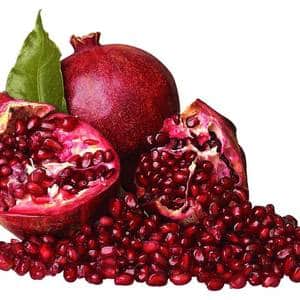
Pomegranate is a plant from the genus Pomegranate of the Derbennikov family, with edible fruits. Place of origin: Asia. Today, pomegranate is widely grown in the Caucasus, the Mediterranean, the Middle East, some regions of Asia, northern and tropical Africa.
It is a perennial tree of subtropical climate. It lives for about 50-60 years, after which the yield decreases and old plantings are replaced with new ones. On average, 50-60 kg of crop is harvested from one tree. The biological period of maturation in nature is extended: in the regions of the northern hemisphere it is September-February, in the southern hemisphere it is March-May.
For reference. As the fruit ripens, the color does not change, making it difficult to determine the time of harvest. If the fruits are unripe, they are left to ripen, maintaining an air humidity of 80% and a temperature of +1...+2⁰С.However, during storage, the quality of the fruit remains virtually unchanged.
What is this fruit
Pomegranate is a juicy edible fruit of the tree; grains, seeds and juice are eaten, as well as other parts of the plant (fruit peel, bark of roots, trunks and branches, membranous partitions) are used as medicinal raw materials. Grains are eaten raw, in cooked dishes, drinks, and processed into juice.
There are only two types of pomegranate in the genus - the common pomegranate and the Socotran pomegranate. In Europe, including Russia, the common pomegranate is popular. The fruits are the size of an orange, covered with a peel from orange-yellow to deep red, taste sweet and sour, sour, less often sweet. The chemical composition is also different and depends on the degree of maturity, growing conditions and storage.
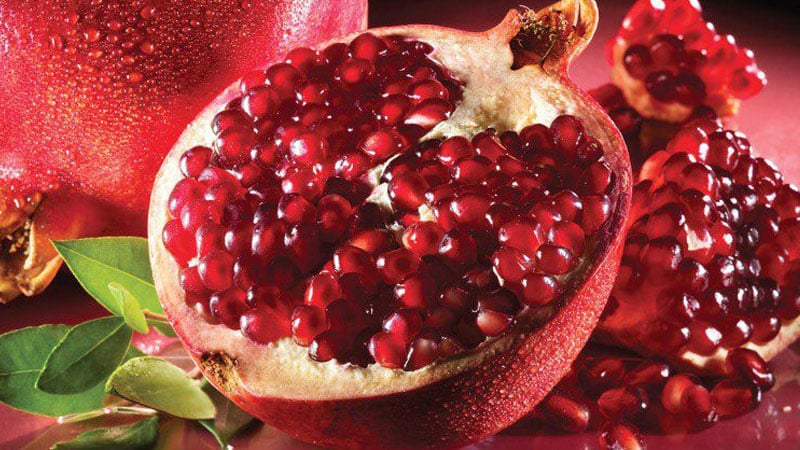
Chemical composition, vitamins and microelements
Pomegranate is a low-calorie product. 100 g contains 72-80 kcal, proteins - 0.7 g, fats - 0.6 g, carbohydrates - 14.5 g. Nature has generously enriched the fruits with substances beneficial to the human body. The composition contains a diverse complex of biologically active components, including:
- omega-6;
- vitamin A;
- beta-carotene;
- B vitamins: B1, B2, B3, B4, B5, B6, B9;
- vitamin C;
- vitamin E;
- vitamin H;
- vitamin K;
- vitamin PP;
- macroelements: potassium, calcium, magnesium, sodium, sulfur, phosphorus, chlorine;
- trace elements: iron, iodine, cobalt, manganese, copper, molybdenum, selenium, fluorine, chromium, zinc.
Benefits of pomegranate
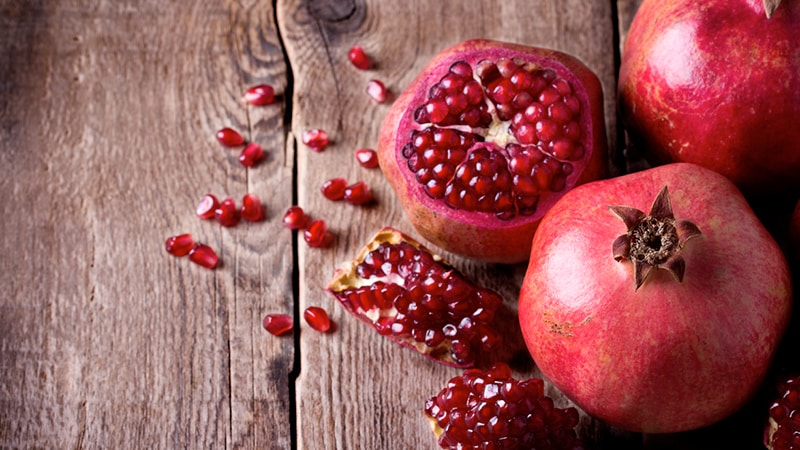
The seeds and pulp of pomegranate contain many important substances for the body that provide basic vital processes:
- Urolitin A. It is a powerful antioxidant, reduces the severity of inflammation, and reduces the risk of developing cancer.
- Retinol. Slows down the aging process, accelerates the healing of wounds and damaged mucous membranes, increases the body's resistance to intestinal diseases, supports the proper functioning of the visual organs, sweat and sebaceous glands.
- B vitamins. They improve the functioning of the nervous system, activate memory and thinking processes, and increase stress resistance. Also necessary for the normal course of growth and development of the body, proper functioning of the heart, and maintaining the health of the digestive and hematopoietic systems.
- Vitamin C. Has a general strengthening effect, protects against infections. Ascorbic acid reduces the fragility and permeability of capillaries, strengthens the vascular wall, which serves as a good prevention of blood clots and circulatory disorders.
- Vitamin E. Preserves the youth and beauty of the skin, normalizes metabolic processes in tissues, supports the activity of the sex glands, reduces blood glucose levels, alleviates Parkinson's and Alzheimer's disease, and prevents the development of senile dementia.
- Amino acids (among them are five irreplaceable ones). They are of great importance for the normal functioning of the brain, take part in the synthesis of proteins, supply muscle tissue with energy, and help vitamins and minerals to fully perform their functions.
- Cellulose. Strengthens intestinal motility, cleanses of waste and toxins, improves digestion, activates metabolism, regulates and maintains normal microflora.
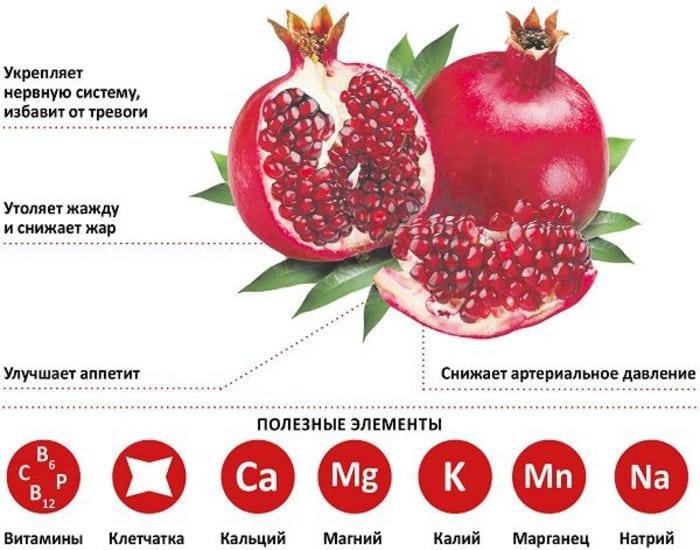
Pomegranate grains and juice are used to treat and prevent various diseases and conditions.The juice is recommended to be taken for anemia to increase the level of hemoglobin and the number of red blood cells, since the vitamin K present in the composition takes part in the formation of new blood cells.
The juice alleviates the severity of symptoms and prevents possible complications in diabetes mellitus, ischemia, and myocardial infarction. Possessing a diuretic property, berries stabilize high blood pressure, reduce the load on the heart muscle, and remove excess fluid from the body, thereby eliminating edema.
Pomegranate juice and grains promote faster recovery after operations and illnesses, strengthen the immune system, accelerate tissue regeneration, and serve as a source of vitamins, micro- and macroelements necessary for the body. Indications for the use of pomegranate berries include acute and chronic infectious diseases, neurological disorders, stress and fatigue, vitamin deficiency, obesity, and unbalanced nutrition.
For women
The presence of vitamins B, E, C, H, PP, as well as other components, makes pomegranate an indispensable product in the diet of women. The fruit has a positive effect on mood and health in general, and has a cosmetic effect on the condition of hair and nails.
A varied vitamin and mineral complex enriches the skin with beneficial substances, normalizes metabolism, reduces the appearance of cellulite, and stimulates collagen production. Fatty acids saturate the skin with moisture and normalize the condition of membrane fats. Vitamin E protects against the negative effects of UV rays. Pomegranate restores hair structure, activates its growth, and improves the condition of nails.
Its value for women is due to the presence of B vitamins, which maintain normal hormonal levels and preserve the functions of the reproductive system. Pomegranate has a general strengthening effect on the body during pre- and postmenopause, and alleviates the severity of symptoms such as dizziness, weakness, irritability, increased sweating, and hot flashes.
B vitamins together with folic acid ensure proper functioning of the nervous system and prevent the development of vegetative-vascular disorders. Calcium and vitamin D strengthen bone tissue, preventing the development of osteoporosis (decreased bone density).
During pregnancy

Pomegranate berries and pomegranate juice during pregnancy additionally saturate the body with minerals, fatty acids, and vitamins:
- Vitamin A ensures the physiological process of ovulation and the functioning of the corpus luteum. Its main task is the production of progesterone, necessary for the development and maintenance of pregnancy, and the prevention of menstruation.
- Pyridoxine (vitamin B6) helps with toxicosis, normalizes and supports the activity of the nervous system, promotes better absorption of vitamin B1.
- Pantothenic acid (vitamin B5) reduces stress, increases endurance.
- Potassium participates in the formation of bone tissue and the formation of dental elements in a baby, and prevents the leaching of calcium from the mother’s body.
- Zinc together with ascorbic acid, they protect the body of the woman and the fetus from the influence of free radicals, and take part in the processes of growth and development of the skin.
The main importance of pomegranate during the period of planning and bearing a child is saturating the body with folic acid.This element is vital both for the health of the mother and for the growth, development of tissues and organs of the fetus. It affects the appetite and mood of women, and is involved in the creation of baby cells. Folic acid deficiency can cause the development of pathologies in the nervous and cardiovascular systems of the fetus.
During breastfeeding
Pomegranate promotes the active restoration of a woman’s body after childbirth and replenishes the lack of vitamins and minerals in the body. Biologically active components serve as a good prevention of osteoporosis and iron deficiency anemia, increase immunity, and improve overall well-being.
Manganese in the fruit activates the reproductive functions of the female body, vitamin B improves memory and reduces irritability, which allows the body to calmly perceive the influence of external stimuli, helps to avoid or more easily endure postpartum depression.
For men
Pomegranate is no less useful for men's health. It serves as an additional source of zinc, selenium, manganese, vitamin E, which have a variety of beneficial effects on the body:
- Restore metabolic processes in the prostate gland.
- Makes urination easier.
- They enhance potency, support reproductive health, and improve sperm quality.
- Participate in the development of muscle tissue.
- Increases vitality, endurance and performance.
Possessing anti-inflammatory, tonic, immunostimulating effects, pomegranate prevents urological diseases and protects against infections.
For children

Pomegranate contains vitamins and minerals necessary for the full growth, physical and intellectual development of the child’s body. Thanks to a balanced combination of biologically active components, pomegranate promotes the active formation of bone and muscle tissue and mineralization of teeth. The fruit also provides prevention of caries, anemia, and increases the body's defenses.
Children who regularly consume pomegranate experience active intellectual development, the body's adaptive capabilities increase, concentration and memory improve, and the likelihood of developing diseases decreases.
For the elderly
A deficiency of vitamins and minerals in the body of older people negatively affects the general state of health and well-being, and the likelihood of developing cardiovascular and nervous diseases increases.
The active components in pomegranate are indispensable for the normal functioning of the heart, the condition of the skeletal system and skeletal muscles:
- vitamin A inhibits the aging process;
- B vitamins minimize the risk of senile dementia;
- Vitamin E tones the skin, enhances collagen production;
- calcium maintains adequate bone density;
- magnesium stabilizes blood pressure.
The benefits of pomegranate for the elderly are associated with the presence of vitamin C, which regulates the concentration of cholesterol in the blood, thereby avoiding atherosclerosis and associated complications: ischemia, myocardial infarction.
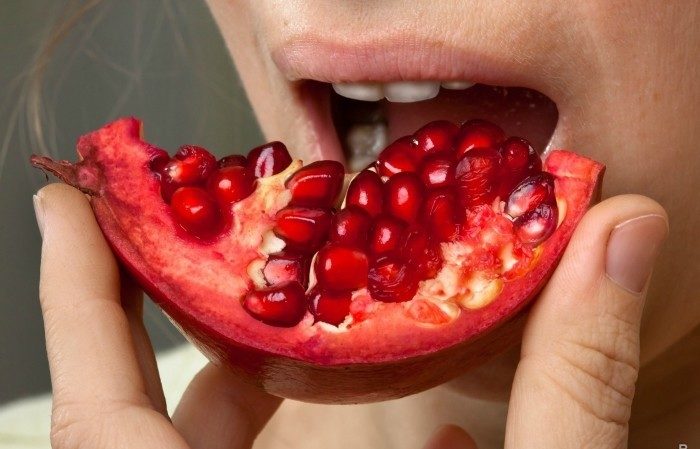
For diabetics
A diet for diabetes does not prohibit, and in some cases even recommends, pomegranate. This is a product with a low glycemic index (35 units), takes longer to digest, insulin is produced gradually, without overloading the pancreas and maintaining adequate blood glucose levels.
Pomegranate seeds are an additional source of fiber, which slows down the absorption of sugar from complex carbohydrates and restores impaired carbohydrate, protein and lipid metabolism.
The benefits of pomegranate are obviouswhen diabetes mellitus develops against a background of obesity. The main advantage of fruit for weight loss is its low calorie content. Grains contain virtually no fat, but are rich in proteins and carbohydrates, which the body needs to be full.
Possible harm and contraindications
The benefits and harms of pomegranate are associated with the presence of amino acids, which, when consumed in excess, have an irritating effect on the mucous membranes of the digestive system. For this reason, pomegranate is contraindicated for people with gastrointestinal diseases, especially during acute periods. All the same organic acids and vitamin C, when consumed in abundance, destroy tooth enamel and increase the hypersensitivity of dental tissues to temperature and chemical irritants.
Attention! Pomegranate is a strong allergen. Consumption of grains or pomegranate juice in excess of the norm, especially in people with hypersensitivity to the product, threatens the development of an allergic reaction.
Other contraindications to consuming pomegranate include severe renal and liver failure, severe urolithiasis, recent surgery on the digestive organs, and hemorrhoids.
How to eat pomegranate correctly

You can eat pomegranate for health benefits both with and without bones. Those who do not have problems with the gastrointestinal tract can eat berries with seeds, chewing them thoroughly. If the seeds are very hard (this depends on the conditions growing, degree of ripeness of pomegranate), then it is better not to consume them.
Pomegranate is eaten in its pure form, combined with other fruits and vegetables, dairy and fermented milk products, lean meats, and seafood. Juice is also squeezed out of the fruits. This is a concentrated drink, so it is first diluted with water or any other vegetable or fruit juice in equal proportions. The water should be filtered and at room temperature. To preserve tooth enamel, you should drink the juice through a cocktail straw, and after each dose, rinse your mouth thoroughly with water.
Advice. Freshly squeezed pomegranate juice cannot be stored; it must be drunk within 20-30 minutes after preparation. If it is necessary to extend the shelf life by 12-24 hours, the juice is poured into a sterile glass container and stored in the refrigerator with the lid closed.
How to clean

There are several simple ways to carefully and quickly peel a pomegranate:
- First way. Using a sharp knife, cut off the top and open the pomegranate little by little, picking out the grains with your fingers.
- Second way. Cut the fruit into two equal parts. Place one half cut side down over the dish and gently tap with a spoon (kitchen spatula) without effort until the grains fall out.
- Third way. Remove the top of the fruit, cut crosswise into two equal parts and fill with water at room temperature. Leave the fruit for 5-10 minutes, then disassemble the pomegranate into grains directly in the water. Place the grains in a colander to remove excess water.
What happens if you eat pomegranate every day?
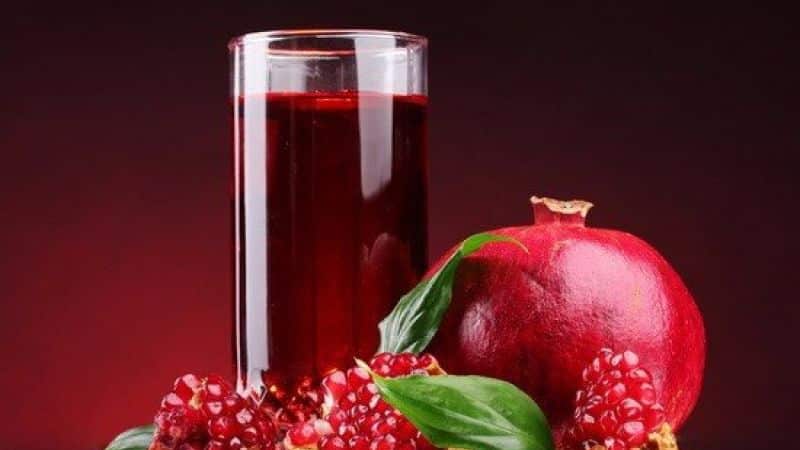
This depends on the daily intake, general health, in particular the digestive system, and the presence of other contraindications.It is not advisable to consume pomegranate daily for children and persons diagnosed with gastrointestinal diseases such as colitis, stomach and duodenal ulcers, and gastritis. It is advisable to limit the amount of pomegranate if you are prone to low blood pressure, since the berries reduce blood pressure levels.
In other cases, if health conditions allow, it is allowed to eat pomegranate every day, but within normal limits.
Daily norm
There is no upper or lower limit as such. On average, without harm to health, it is enough for a healthy adult to eat one medium-sized pomegranate or drink 200-300 ml of pomegranate juice. If there are contraindications, the daily dose is reduced.
Best time of day to eat pomegranate
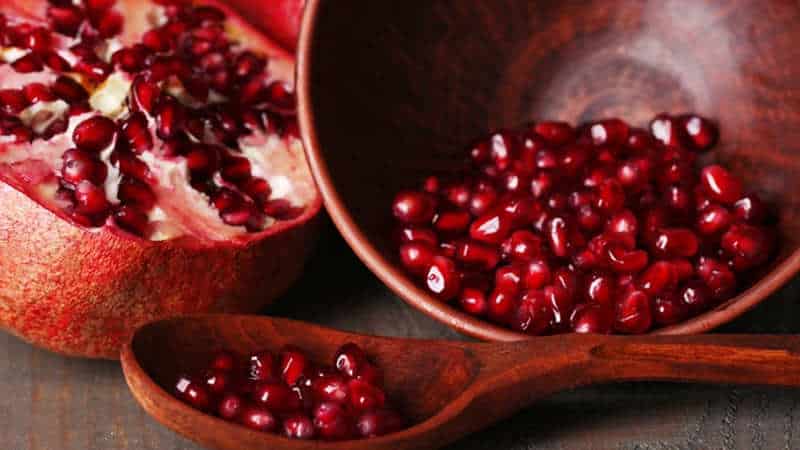
Pomegranate can be consumed at any meal - breakfast, lunch, dinner or between main meals during the day. It is more advisable to include pomegranate in the diet in the first half of the day. The fact is that the fiber it contains quickly and for a long time satisfies the feeling of hunger, allowing you to reduce the volume of subsequent meals and give up snacking, which is especially important when losing weight. It contains complex carbohydrates that fill the body with energy, increase productivity, and stimulate physical activity.
Nutritionists do not recommend pomegranate or pomegranate juice on an empty stomach. Taking it on an empty stomach irritates the mucous membranes, which is manifested by increased fermentation, colic, a feeling of bloating, and in the presence of digestive problems - exacerbation of symptoms.
Is it possible to eat at night
Nutritionists do not prohibit eat pomegranate at night, but in moderation. The pomegranate itself satisfies hunger for a long time, while it has a low calorie content and is not deposited as extra centimeters on the waist and hips.Due to the fact that fiber takes a long time to digest, the last intake of fruit should be no later than 2-3 hours before bedtime. During this time, the berries are completely absorbed without overloading the gastrointestinal tract.
For reference. Another argument in favor of eating pomegranate at night is the presence of B vitamins, which calm the nervous system and improve the quality of sleep.
At what age can you eat pomegranate?

Pomegranate, grown in safe conditions without the use of pesticides, is beneficial for men and women of any age. Children begin to be introduced to the fruit after one year. Initially, pomegranate juice is offered in limited quantities. Due to the fact that pomegranate is highly allergenic, it is necessary to introduce it into the diet in small quantities, starting with 1 tsp, observing the body’s reaction.
Important. Concentrated juice is contraindicated for children. It is pre-diluted with purified water in equal proportions or with another fruit or vegetable juice that the baby has already tried.
Children over two years old can be offered grains, but for this it is better to choose seedless varieties or those with a soft seed. It is important to ensure that your child does not eat the seeds, as his digestive system is not able to completely digest the kernels.
There is no clearly established daily intake for children. Without the risk of negative reactions, children from 2 to 3 years old can eat a quarter of a pomegranate, from 3 to 7 years old - half, over 7 years old - one medium-sized pomegranate.
How often can children eat pomegranate? It all depends on the state of the digestive system, contraindications and age. Pediatricians recommend including pomegranate in a child’s diet no more than 2-3 times a week.
Is it possible to eat pomegranate with seeds?
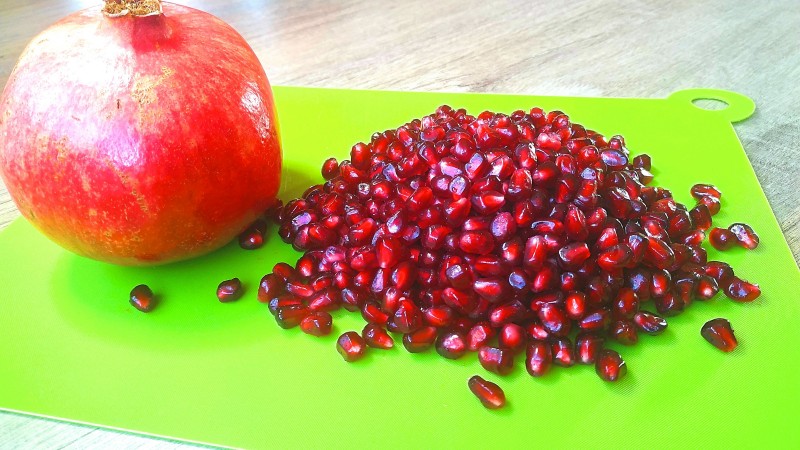
Is it possible to eat pomegranate with seeds? Partly this is a matter of habit and taste of each person. Bones are no less useful and act as an additional source of fiber, vitamin E, and vegetable fats. But they will only bring benefits in crushed form. Therefore, if you prefer to eat pomegranate with seeds, they must be chewed thoroughly.
What happens if you eat it with seeds?
Crushed seeds in moderation and in the absence of contraindications will not cause harm to health. But whole bones can cause inflammation of the appendix and increase the symptoms of chronic diseases of the digestive system such as gastritis, colitis, gastric and duodenal ulcers. The hard woody shell has an irritating effect on damaged mucous membranes and organs, which is manifested by pain, increased gas formation, and a feeling of bloating.
How long does it take to digest a pomegranate with seeds?
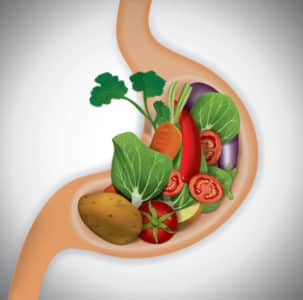
The pulp of the grains is quickly and well absorbed; it is digested in the stomach in 30-40 minutes, and the body spends 3-4 hours on complete digestion and assimilation by cells. The situation with bones is different. Fiber, which is contained in large quantities in grains, is difficult to deal with gastric juice, which is why the body is not able to digest the kernels, but only receives nutrients from them, and eliminates the grains themselves unchanged.
To facilitate the process of digesting pomegranate seeds, nutritionists recommend chewing the seeds thoroughly and choosing varieties with soft seeds.
Conclusion
Thanks to its composition, pomegranate has anti-inflammatory, analgesic, tonic, antispasmodic, diuretic, bactericidal effects, stimulates metabolism, strengthens the immune system, and relieves psychological stress. But its benefits directly depend on the quality of the fruit, growing and storage conditions, and the amount of product eaten.